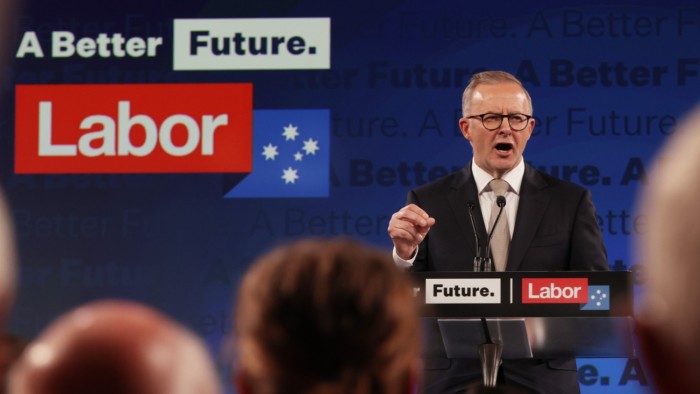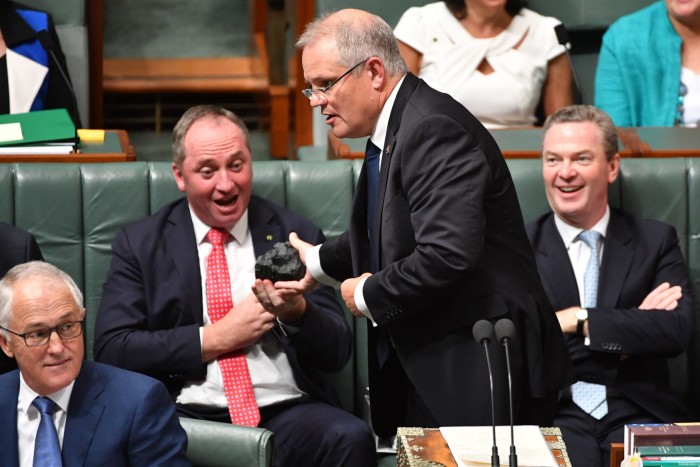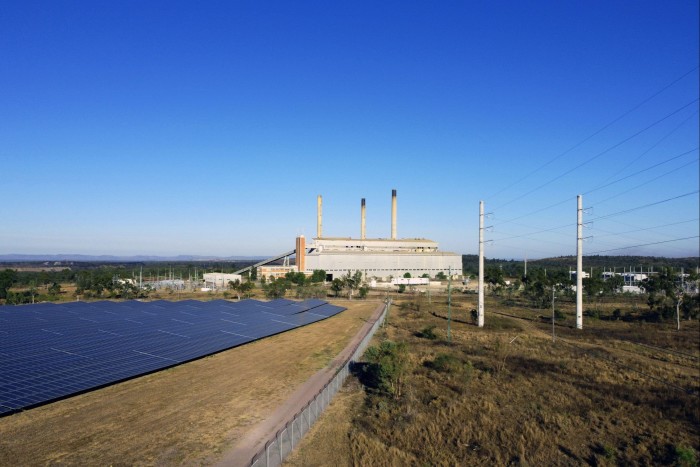Australia takes steps to catch up on climate action

Simply sign up to the Climate change myFT Digest -- delivered directly to your inbox.
Anote Tong, the former president of the Pacific island nation Kiribati, has high expectations of his larger neighbours.
“I have looked to Australia to be a leader in climate change,” he says. But the country’s climate policies over the past decade have been mostly disappointing for Pacific island leaders.
“Climate change is always made out to be a Pacific islands problem,” Tong notes. “It is not. It is a global problem. It is an Australian problem.”
He was speaking on a trip to Sydney following the May election of Australia’s first Labor prime minister in almost a decade, Anthony Albanese.
The result swept aside Scott Morrison , who once brandished a lump of coal in parliament to demonstrate his party’s commitment to the fossil fuel industry and whose policies had earned the country a global reputation as a climate change laggard.

The Greens and independent pro-climate “Teal” candidates also did well in the election, the latter gaining affluent seats in Sydney and Melbourne.
It therefore promises a new era for the country, after years in which climate has been a divisive political issue. Australians — who have endured devastating bushfires and floods in recent years — have seemingly voted for change.
Already, the new government has passed a bill to bind the country to reducing greenhouse gas emissions by 43 per cent from 2005 levels by 2030. The bill also enshrined a commitment to net zero by 2050 , which Albanese said would put the country on the “right side of history”. It coincided with a government decision to block a new open pit coal mine located 10km from the Great Barrier Reef.
David Thodey, who chairs software company Xero, says the business community has been encouraged by these decisions for being on the “practical end of the spectrum”.
Thodey is also chair of the Climate Leaders Coalition, a forum of nearly 50 top businesses in the country including BHP, Rio Tinto and Qantas , which formed last year to compare decarbonisation strategies.
“In the absence of political leadership, historically, we have just decided to get on with it,” says Thodey.
He says many chief executives were already under pressure from shareholders and their own employees to tackle climate change, and believes companies should share their experiences of switching to renewables and reducing “Scope 3” emissions — the greenhouse gases emitted across a supply chain and in the use of their products. That way, they can learn from each other and work out best practices.
“We need to avoid greenwashing and put reality on the table,” he suggests. “Most people have a commitment to decarbonisation but [they] have questions as well.”
The country’s critical minerals sector should benefit from decarbonisation as it supplies the nickel, lithium and rare earths needed by battery makers, electric vehicle manufacturers and renewable energy companies.
Meanwhile, the domestic energy transition — bolstered by government support of renewable projects and a new A$20bn fund unveiled in the budget — is also seen as an opportunity.
Star of the South, backed by the Cbus superannuation fund and international investors, plans to construct Australia’s first offshore wind project off the south coast by 2030, and chief executive Charles Rattray says government decisions have helped advance the project.
“By setting targets and committing to clean energy — including offshore wind — Australia has become a vibrant place to invest,” he says.

Yet Australia’s climate policies are still not ambitious enough for some. Albanese and his ministers have stressed how tough the 2030 target is but have refused demands from the Greens for a moratorium for new fossil fuel projects — including coal — as it would have a devastating impact on Australia’s economy and workforce.
The Greens have called for amendments to environmental laws to at least stop projects that would emit more than 100,000 tonnes of carbon a year.
Euan Ritchie, an ecology professor with Deakin University in Victoria, says much more needs to be done, pointing out that a number of species in Australia are under severe threat of extinction due to climate change.
More stories from this report
‘Loss and damage’ debate set to dominate the COP27 agenda
US needs yet more ‘huge lift’ to hit Paris goals
Amazon woes overshadow Brazil’s farming advances
UK’s COP26 chief ‘fully invested’ in continued climate champion role
European crisis risks climate action reputation
India plots tricky path to growth and net zero
Pressure remains on Xi Jinping to kick China’s coal habit
Cairo sets agenda for ‘the African COP’ at Red Sea resort
‘Loss and damage’ stalemate has reached breaking point
The plight of the Bramble Cay melomys — a small mammal that was the first to be declared extinct due to climate change as rising ocean levels wiped out its habitat — emphasises the risk of inaction, says Ritchie.
“Political commitments appear wafer-thin when the same politicians continue to approve the destruction of the homes critically endangered species depend upon,” he says.
“Greenhouse gas emissions reduction targets are far below what climate scientists say are essential.”
For Pacific islanders, who also face the threat of a rising ocean, the Australian government’s policies hit close to home.
Albanese was quick to visit the region after the election to stress the renewed focus on net zero, and subsequently increased development aid and relief — such as funds to Kiribati for drought assistance — to the region.
But some are holding back judgment. “The main frustration is the gap between what is said and what is done,” says Tommy Remengesau, a former president of Micronesian country Palau. “We’re hoping that this time around it is a different story.”
Comments